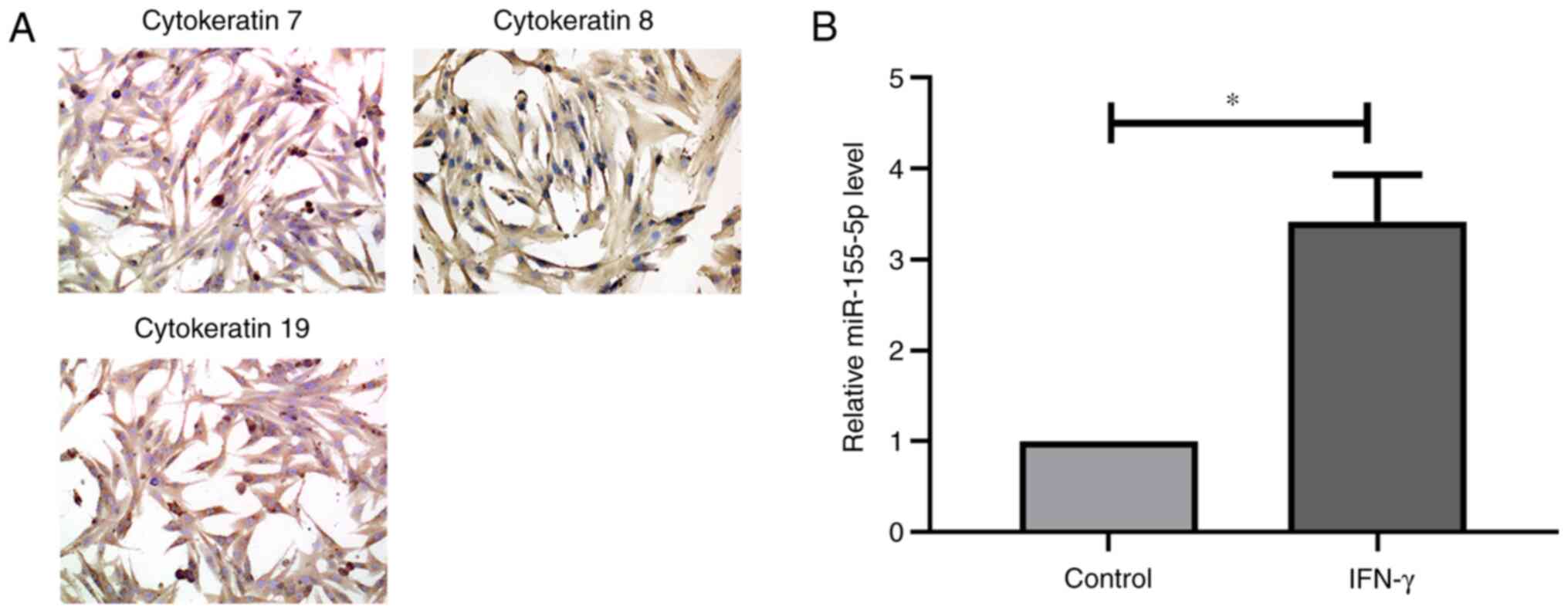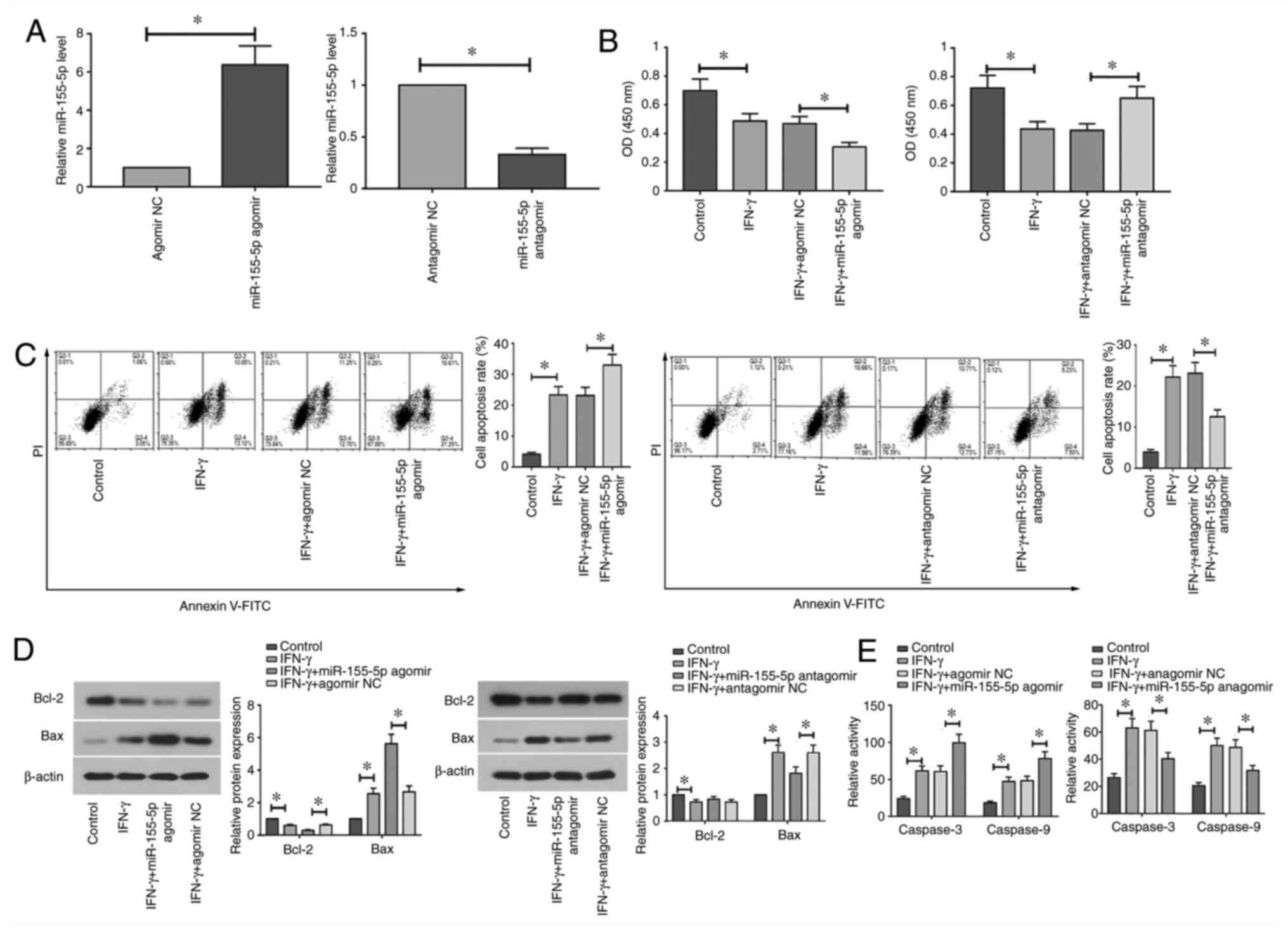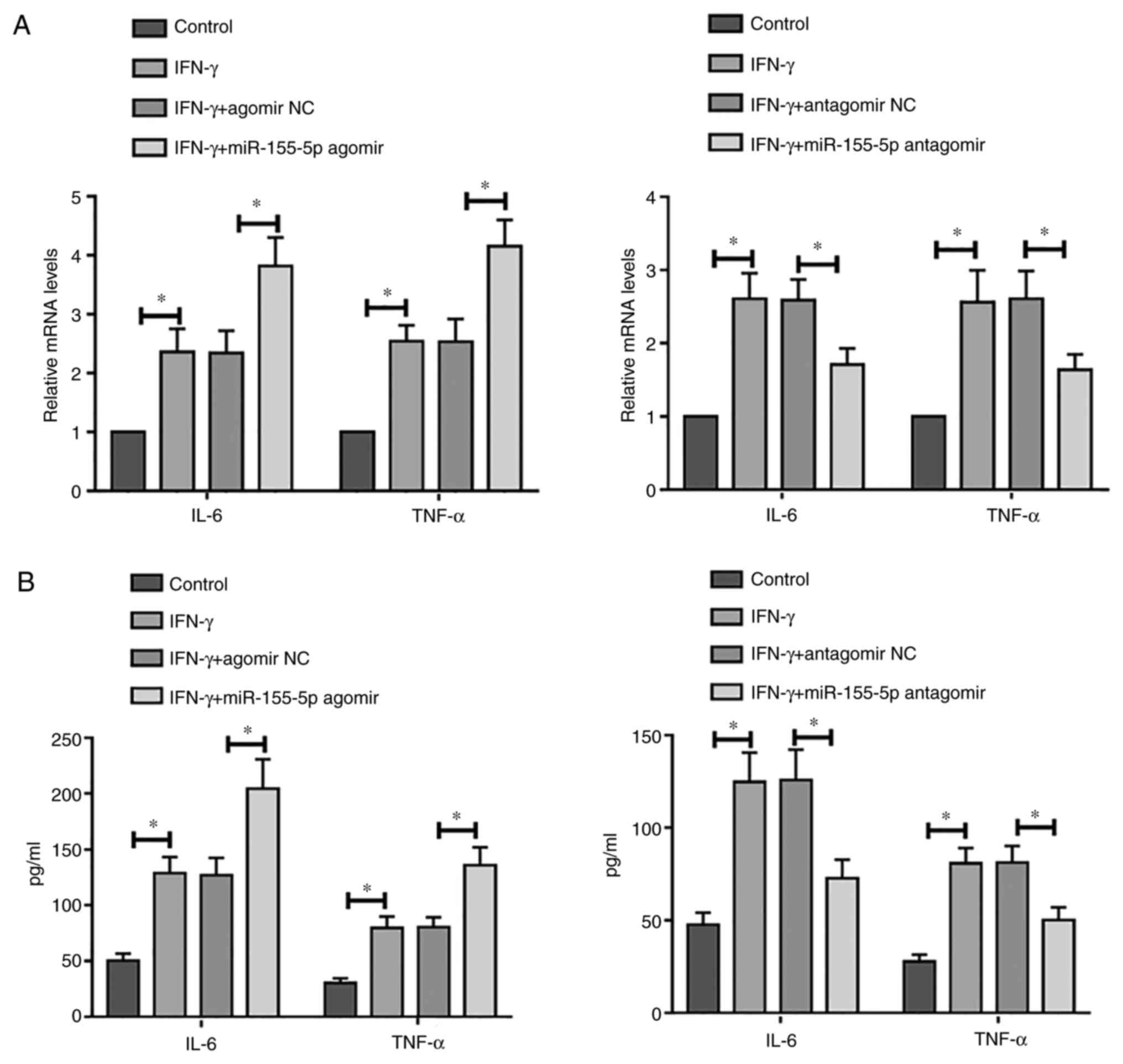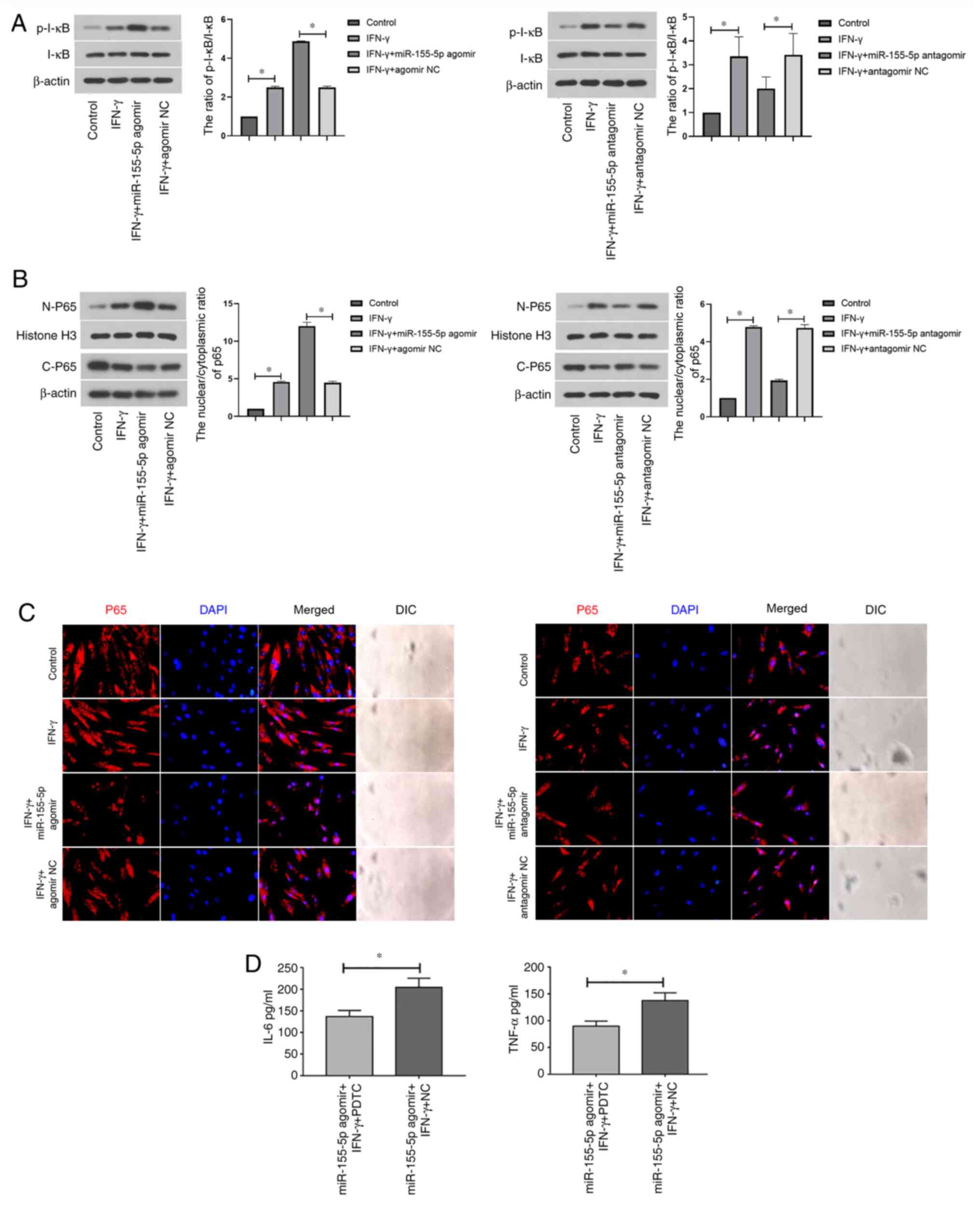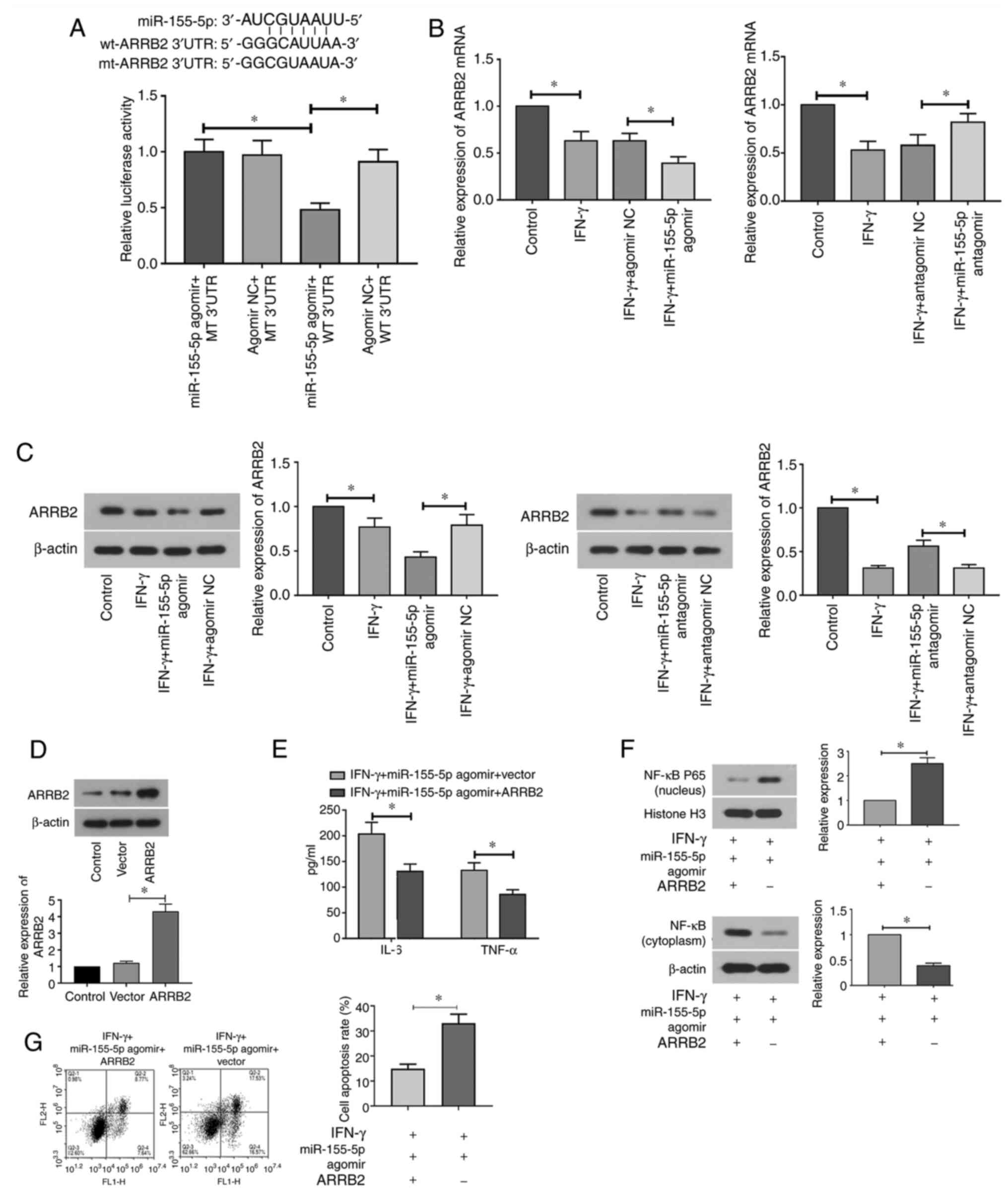|
1
|
Baldini C, Talarico R, Tzioufas AG and
Bombardieri S: Classification criteria for Sjogren's syndrome: A
critical review. J Autoimmun. 39:9–14. 2012.PubMed/NCBI View Article : Google Scholar
|
|
2
|
Reale M, D'Angelo C, Costantini E, Laus M,
Moretti A and Croce A: MicroRNA in Sjögren's syndrome: Their
potential roles in pathogenesis and diagnosis. J Immunol Res.
2018(7510174)2018.PubMed/NCBI View Article : Google Scholar
|
|
3
|
Ramos-Casals M, Tzioufas AG and Font J:
Primary Sjögren's syndrome: New clinical and therapeutic concepts.
Ann Rheum Dis. 64:347–354. 2005.PubMed/NCBI View Article : Google Scholar
|
|
4
|
Jimenez SA and Piera-Velazquez S:
Potential role of human-specific genes, human-specific microRNAs
and human-specific non-coding regulatory RNAs in the pathogenesis
of systemic sclerosis and Sjögren's syndrome. Autoimmun Rev.
12:1046–1051. 2013.PubMed/NCBI View Article : Google Scholar
|
|
5
|
Saito M, Ota Y, Ohashi H, Dei Y, Shimoyama
K, Suzuki D, Hayashi H and Ogawa N: CD40-CD40 ligand signal induces
the intercellular adhesion molecule-1 expression through nuclear
factor-kappa B p50 in cultured salivary gland epithelial cells from
patients with Sjögren's syndrome. Mod Rheumatol. 17:45–53.
2007.PubMed/NCBI View Article : Google Scholar
|
|
6
|
Gottenberg JE, Cagnard N, Lucchesi C,
Letourneur F, Mistou S, Lazure T, Jacques S, Ba N, Ittah M,
Lepajolec C, et al: Activation of IFN pathways and plasmacytoid
dendritic cell recruitment in target organs of primary Sjögren's
syndrome. Proc Natl Acad Sci USA. 103:2770–2775. 2006.PubMed/NCBI View Article : Google Scholar
|
|
7
|
Bushati N and Cohen SM: MicroRNA
functions. Annu Rev Cell Dev Biol. 23:175–205. 2007.PubMed/NCBI View Article : Google Scholar
|
|
8
|
Chen CZ, Li L, Lodish HF and Bartel DP:
MicroRNAs modulate hematopoietic lineage differentiation. Science.
303:83–86. 2004.PubMed/NCBI View Article : Google Scholar
|
|
9
|
Mestdagh P, Feys T, Bernard N, Guenther S,
Chen C, Speleman F and Vandesompele J: High-throughput stem-loop
RT-qPCR miRNA expression profiling using minute amounts of input
RNA. Nucleic Acids Res. 36(e143)2008.PubMed/NCBI View Article : Google Scholar
|
|
10
|
Wang F, Shan S, Huo Y, Xie Z, Fang Y, Qi
Z, Chen F, Li Y and Sun B: miR-155-5p inhibits PDK1 and promotes
autophagy via the mTOR pathway in cervical cancer. Int J Biochem
Cell Biol. 99:91–99. 2018.PubMed/NCBI View Article : Google Scholar
|
|
11
|
Elton TS, Selemon H, Elton SM and
Parinandi NL: Regulation of the MIR155 host gene in physiological
and pathological processes. Gene. 532:1–12. 2013.PubMed/NCBI View Article : Google Scholar
|
|
12
|
Jiang K, Hu J, Luo G, Song D, Zhang P, Zhu
J and Sun F: miR-155-5p promotes oxalate- and calcium-induced
kidney oxidative stress injury by suppressing MGP expression. Oxid
Med Cell Longev. 2020(5863617)2020.PubMed/NCBI View Article : Google Scholar
|
|
13
|
Goncalves-Alves E, Saferding V, Schliehe
C, Benson R, Kurowska-Stolarska M, Brunner JS, Puchner A, Podesser
BK, Smolen JS, Redlich K, et al: MicroRNA-155 controls T helper
cell activation during viral infection. Front Immunol.
10(1367)2019.PubMed/NCBI View Article : Google Scholar
|
|
14
|
Vigorito E, Kohlhaas S, Lu D and Leyland
R: miR-155: An ancient regulator of the immune system. Immunol Rev.
253:146–157. 2013.PubMed/NCBI View Article : Google Scholar
|
|
15
|
Tavasolian F, Abdollahi E, Rezaei R,
Momtazi-Borojeni AA, Henrotin Y and Sahebkar A: Altered expression
of microRNAs in rheumatoid arthritis. J Cell Biochem. 119:478–487.
2018.PubMed/NCBI View Article : Google Scholar
|
|
16
|
Cao W, Qian G, Luo W, Liu X, Pu Y, Hu G,
Han L, Yuan L, A X and Deng D: miR-125b is downregulated in
systemic lupus erythematosus patients and inhibits autophagy by
targeting UVRAG. Biomed Pharmacother. 99:791–797. 2018.PubMed/NCBI View Article : Google Scholar
|
|
17
|
Johansson A, Nyberg WA, Sjöstrand M,
Moruzzi N, Bergman P, Khademi M, Andersson M, Piehl F, Berggren PO,
Covacu R, et al: miR-31 regulates energy metabolism and is
suppressed in T cells from patients with Sjögren's syndrome. Eur J
Immunol. 49:313–322. 2019.PubMed/NCBI View Article : Google Scholar
|
|
18
|
Gourzi VC, Kapsogeorgou EK, Kyriakidis NC
and Tzioufas AG: Study of microRNAs (miRNAs) that are predicted to
target the autoantigens Ro/SSA and La/SSB in primary Sjögren's
syndrome. Clin Exp Immunol. 182:14–22. 2015.PubMed/NCBI View Article : Google Scholar
|
|
19
|
Chen JQ, Zilahi E, Papp G, Sipka S and
Zeher M: Simultaneously increased expression of microRNA-155 and
suppressor of cytokine signaling 1 (SOCS1) gene in the peripheral
blood mononuclear cells of patients with primary Sjögren's
syndrome. Int J Rheum Dis. 20:609–613. 2017.PubMed/NCBI View Article : Google Scholar
|
|
20
|
Wang X, Huang G, Mu J, Cong Z, Chen S, Fu
D, Qi J and Li Z: Arrb2 promotes endothelial progenitor
cell-mediated postischemic neovascularization. Theranostics.
10:9899–9912. 2020.PubMed/NCBI View Article : Google Scholar
|
|
21
|
Chen G, Xie RG, Gao YJ, Xu ZZ, Zhao LX,
Bang S, Berta T, Park CK, Lay M, Chen W and Ji RR: β-arrestin-2
regulates NMDA receptor function in spinal lamina II neurons and
duration of persistent pain. Nat Commun. 7(12531)2016.PubMed/NCBI View Article : Google Scholar
|
|
22
|
Kallifatidis G, Smith DK, Morera DS, Gao
J, Hennig MJ, Hoy JJ, Pearce RF, Dabke IR, Li J, Merseburger AS, et
al: β-arrestins regulate stem cell-like phenotype and response to
chemotherapy in bladder cancer. Mol Cancer Ther. 18:801–811.
2019.PubMed/NCBI View Article : Google Scholar
|
|
23
|
Sharma D, Malik A, Lee E, Britton RA and
Parameswaran N: Gene dosage-dependent negative regulatory role of
β-arrestin-2 in polymicrobial infection-induced inflammation.
Infect Immun. 81:3035–3044. 2013.PubMed/NCBI View Article : Google Scholar
|
|
24
|
Zeng LX, Tao J, Liu HL, Tan SW, Yang YD,
Peng XJ, Liu ZH, Jiang J and Wu B: β-arrestin2 encourages
inflammation-induced epithelial apoptosis through ER stress/PUMA in
colitis. Mucosal Immunol. 8:683–695. 2015.PubMed/NCBI View Article : Google Scholar
|
|
25
|
Gaffal E, Jakobs M, Glodde N, Schröder R,
Kostenis E and Tüting T: β-arrestin 2 inhibits proinflammatory
chemokine production and attenuates contact allergic inflammation
in the skin. J Invest Dermatol. 134:2131–2137. 2014.PubMed/NCBI View Article : Google Scholar
|
|
26
|
Jiang MP, Xu C, Guo YW, Luo QJ, Li L, Liu
HL, Jiang J, Chen HX and Wei XQ: β-arrestin 2 attenuates
lipopolysaccharide-induced liver injury via inhibition of
TLR4/NF-κB signaling pathway-mediated inflammation in mice. World J
Gastroenterol. 24:216–225. 2018.PubMed/NCBI View Article : Google Scholar
|
|
27
|
Vakrakou AG, Polyzos A, Kapsogeorgou EK,
Thanos D and Manoussakis MN: Impaired anti-inflammatory activity of
PPARγ in the salivary epithelia of Sjögren's syndrome patients
imposed by intrinsic NF-κB activation. J Autoimmun. 86:62–74.
2018.PubMed/NCBI View Article : Google Scholar
|
|
28
|
Sisto M, Barca A, Lofrumento DD and Lisi
S: Downstream activation of NF-κB in the EDA-A1/EDAR signalling in
Sjögren's syndrome and its regulation by the ubiquitin-editing
enzyme A20. Clin Exp Immunol. 184:183–196. 2016.PubMed/NCBI View Article : Google Scholar
|
|
29
|
National Research Council (US) Committee
for the Update of the Guide for the Care and Use of Laboratory
Animals: Guide for the care and use of laboratory animals. 8th
edition. Washington (DC), National Academies Press (US), 2011.
|
|
30
|
Xin M, Liang H, Wang H, Wen D, Wang L,
Zhao L, Sun M and Wang J: Mirt2 functions in synergy with miR-377
to participate in inflammatory pathophysiology of Sjögren's
syndrome. Artif Cells Nanomed Biotechnol. 47:2473–2480.
2019.PubMed/NCBI View Article : Google Scholar
|
|
31
|
Zhang C, Li Y, Zhang XY, Liu L, Tong HZ,
Han TL, Li WD, Jin XL, Yin NB, Song T, et al: Therapeutic potential
of human minor salivary gland epithelial progenitor cells in liver
regeneration. Sci Rep. 7(12707)2017.PubMed/NCBI View Article : Google Scholar
|
|
32
|
Gao Y, Li M, Zhang X, Bai T, Chi G, Liu JY
and Li Y: Isolation, culture and phenotypic characterization of
human sweat gland epithelial cells. Int J Mol Med. 34:997–1003.
2014.PubMed/NCBI View Article : Google Scholar
|
|
33
|
Livak KJ and Schmittgen TD: Analysis of
relative gene expression data using real-time quantitative PCR and
the 2(-Delta Delta C(T)) method. Methods. 25:402–408.
2001.PubMed/NCBI View Article : Google Scholar
|
|
34
|
Brito-Zerón P, Baldini C, Bootsma H,
Bowman SJ, Jonsson R, Mariette X, Sivils K, Theander E, Tzioufas A
and Ramos-Casals M: Sjogren syndrome. Nat Rev Dis Primers.
2(16047)2016.PubMed/NCBI View Article : Google Scholar
|
|
35
|
Mehta A and Baltimore D: MicroRNAs as
regulatory elements in immune system logic. Nat Rev Immunol.
16:279–294. 2016.PubMed/NCBI View Article : Google Scholar
|
|
36
|
Tahamtan A, Teymoori-Rad M, Nakstad B and
Salimi V: Anti-inflammatory microRNAs and their potential for
inflammatory diseases treatment. Front Immunol.
9(1377)2018.PubMed/NCBI View Article : Google Scholar
|
|
37
|
Ceppi M, Pereira PM, Dunand-Sauthier I,
Barras E, Reith W, Santos MA and Pierre P: MicroRNA-155 modulates
the interleukin-1 signaling pathway in activated human
monocyte-derived dendritic cells. Proc Natl Acad Sci USA.
106:2735–2740. 2009.PubMed/NCBI View Article : Google Scholar
|
|
38
|
Kurowska-Stolarska M, Alivernini S,
Ballantine LE, Asquith DL, Millar NL, Gilchrist DS, Reilly J, Ierna
M, Fraser AR, Stolarski B, et al: MicroRNA-155 as a proinflammatory
regulator in clinical and experimental arthritis. Proc Natl Acad
Sci USA. 108:11193–11198. 2011.PubMed/NCBI View Article : Google Scholar
|
|
39
|
Milic V, Colic J, Cirkovic A, Stanojlovic
S and Damjanov N: Disease activity and damage in patients with
primary Sjogren's syndrome: Prognostic value of salivary gland
ultrasonography. PLoS One. 14(e0226498)2019.PubMed/NCBI View Article : Google Scholar
|
|
40
|
Daniels TE, Silverman S Jr, Michalski JP,
Greenspan JS, Sylvester RA and Talal N: The oral component of
Sjögren's syndrome. Oral Surg Oral Med Oral Pathol. 39:875–885.
1975.PubMed/NCBI View Article : Google Scholar
|
|
41
|
Cha S, Nagashima H, Brown VB, Peck AB and
Humphreys-Beher MG: Two NOD Idd-associated intervals contribute
synergistically to the development of autoimmune exocrinopathy
(Sjögren's syndrome) on a healthy murine background. Arthritis
Rheum. 46:1390–1398. 2002.PubMed/NCBI View Article : Google Scholar
|
|
42
|
Li P, Yang Y, Jin Y, Zhao R, Dong C, Zheng
W, Zhang T, Li J and Gu Z: B7-H3 participates in human salivary
gland epithelial cells apoptosis through NF-κB pathway in primary
Sjögren's syndrome. J Transl Med. 17(268)2019.PubMed/NCBI View Article : Google Scholar
|
|
43
|
Baker OJ, Camden JM, Redman RS, Jones JE,
Seye CI, Erb L and Weisman GA: Proinflammatory cytokines tumor
necrosis factor-alpha and interferon-gamma alter tight junction
structure and function in the rat parotid gland Par-C10 cell line.
Am J Physiol Cell Physiol. 295:C1191–C1201. 2008.PubMed/NCBI View Article : Google Scholar
|
|
44
|
Manganelli P and Fietta P: Apoptosis and
Sjögren syndrome. Semin Arthritis Rheum. 33:49–65. 2003.PubMed/NCBI View Article : Google Scholar
|
|
45
|
Shi Y, Li K, Xu K and Liu QH: miR-155-5p
accelerates cerebral ischemia-reperfusion injury via targeting
DUSP14 by regulating NF-κB and MAPKs signaling pathways. Eur Rev
Med Pharmacol Sci. 24:1408–1419. 2020.PubMed/NCBI View Article : Google Scholar
|
|
46
|
Atreya I, Atreya R and Neurath MF:
NF-kappaB in inflammatory bowel disease. J Intern Med. 263:591–596.
2008.PubMed/NCBI View Article : Google Scholar
|
|
47
|
Roman-Blas JA and Jimenez SA: NF-kappaB as
a potential therapeutic target in osteoarthritis and rheumatoid
arthritis. Osteoarthritis Cartilage. 14:839–848. 2006.PubMed/NCBI View Article : Google Scholar
|
|
48
|
Lisi S, Sisto M, Soleti R, Saponaro C,
Scagliusi P, D'Amore M, Saccia M, Maffione AB and Mitolo V: Fcgamma
receptors mediate internalization of anti-Ro and anti-La
autoantibodies from Sjögren's syndrome and apoptosis in human
salivary gland cell line A-253. J Oral Pathol Med. 36:511–523.
2007.PubMed/NCBI View Article : Google Scholar
|
|
49
|
Sisto M, Lisi S, Lofrumento DD, Ingravallo
G, Maiorano E and D'Amore M: A failure of TNFAIP3 negative
regulation maintains sustained NF-κB activation in Sjögren's
syndrome. Histochem Cell Biol. 135:615–625. 2011.PubMed/NCBI View Article : Google Scholar
|
|
50
|
Lisi S, Sisto M, Lofrumento DD and D'Amore
M: Sjögren's syndrome autoantibodies provoke changes in gene
expression profiles of inflammatory cytokines triggering a pathway
involving TACE/NF-κB. Lab Invest. 92:615–624. 2012.PubMed/NCBI View Article : Google Scholar
|
|
51
|
Wang X, Shaalan A, Liefers S, Coudenys J,
Elewaut D, Proctor GB, Bootsma H, Kroese FGM and Pringle S:
Dysregulation of NF-kB in glandular epithelial cells results in
Sjögren's-like features. PLoS One. 13(e0200212)2018.PubMed/NCBI View Article : Google Scholar
|
|
52
|
Sisto M, Lorusso L and Lisi S: TLR2
signals via NF-κB to drive IL-15 production in salivary gland
epithelial cells derived from patients with primary Sjögren's
syndrome. Clin Exp Med. 17:341–350. 2017.PubMed/NCBI View Article : Google Scholar
|
|
53
|
Lawrence T: The nuclear factor NF-kappaB
pathway in inflammation. Cold Spring Harb Perspect Biol.
1(a001651)2009.PubMed/NCBI View Article : Google Scholar
|
|
54
|
Zhou Y, Song Y, Shaikh Z, Li H, Zhang H,
Caudle Y, Zheng S, Yan H, Hu D, Stuart C and Yin D: MicroRNA-155
attenuates late sepsis-induced cardiac dysfunction through JNK and
β-arrestin 2. Oncotarget. 8:47317–47329. 2017.PubMed/NCBI View Article : Google Scholar
|
|
55
|
Li P, Cook JA, Gilkeson GS, Luttrell LM,
Wang L, Borg KT, Halushka PV and Fan H: Increased expression of
beta-arrestin 1 and 2 in murine models of rheumatoid arthritis:
Isoform specific regulation of inflammation. Mol Immunol. 49:64–74.
2011.PubMed/NCBI View Article : Google Scholar
|
|
56
|
Hong F, Zhang Y, Cheng W, Sun X and Wang
J: β-arrestin-2 up-regulates toll-like receptor 2 signaling and
inhibits apoptosis in human endometrial cancer heterotransplants in
nude mice. BMC Cancer. 19(1035)2019.PubMed/NCBI View Article : Google Scholar
|
|
57
|
Li Y, Sun X, Zhang Y, Huang J, Hanley G,
Ferslew KE, Peng Y and Yin D: Morphine promotes apoptosis via TLR2,
and this is negatively regulated by beta-arrestin 2. Biochem
Biophys Res Commun. 378:857–861. 2009.PubMed/NCBI View Article : Google Scholar
|
|
58
|
Trotta R, Chen L, Ciarlariello D, Josyula
S, Mao C, Costinean S, Yu L, Butchar JP, Tridandapani S, Croce CM
and Caligiuri MA: miR-155 regulates IFN-γ production in natural
killer cells. Blood. 119:3478–3485. 2012.PubMed/NCBI View Article : Google Scholar
|
|
59
|
Yee D, Shah KM, Coles MC, Sharp TV and
Lagos D: MicroRNA-155 induction via TNF-α and IFN-γ suppresses
expression of programmed death ligand-1 (PD-L1) in human primary
cells. J Biol Chem. 292:20683–20693. 2017.PubMed/NCBI View Article : Google Scholar
|
|
60
|
Kim JH, Jou I and Joe EH: Suppression of
miR-155 expression in IFN-γ-treated astrocytes and microglia by
DJ-1: A possible mechanism for maintaining SOCS1 expression. Exp
Neurobiol. 23:148–154. 2014.PubMed/NCBI View Article : Google Scholar
|















